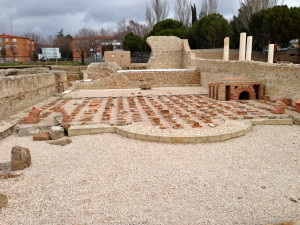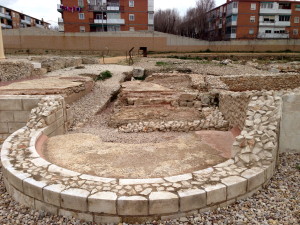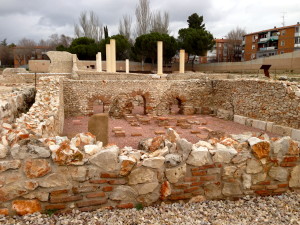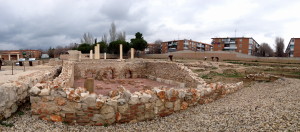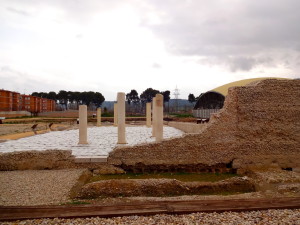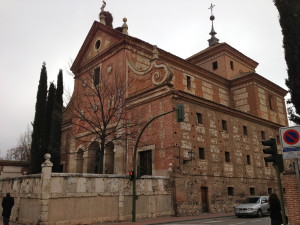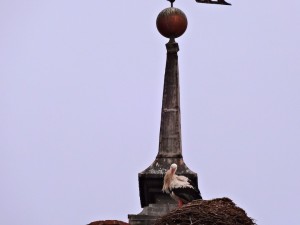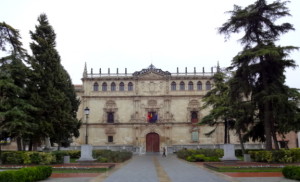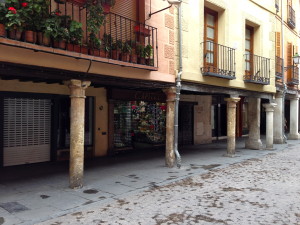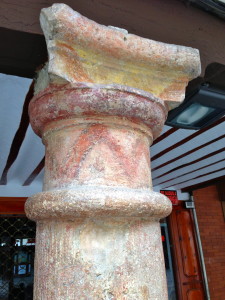Dispatches from Spain: On a Cold Day . . . Alcalá de Henares
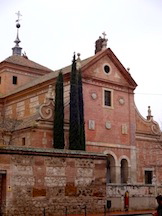
By Ito Romo, NewsTaco
I arrived in Spain on what my landlady told me as she met me at the bus from the airport was the coldest day they’d experienced this winter. The bus dropped me, another professor, and fourteen students from St. Mary’s University at the town square, still dressed in Christmas lights, the sounds of kids yelling and screaming from the seasonal ice skating rink at one end of the plaza.
Thus began our Spring semester in Alcalá de Henares, an ancient city that is now what the Spaniards call a cuidad dormitorio of Madrid, an 800-year-old suburb of the capital city.
For almost two months now, I’ve walked the cobblestone streets for hours and hours almost every day, staring at everything, at old couples dressed elegantly as they take their daily afternoon paseo, at the artistic way plain river rocks are set on the sidewalk of the Cathedral, at giant wooden doors hundreds of years old, a kid’s graffiti tag slowly fading with the cold and the rain, and with time.
Just yesterday, as a matter of fact, I finally made my way to look at something new—well, old, actually, really, really old. Alcalá was founded by the Romans sometime during the 1st Century BC, and the ancient ruins of the old city are just up the street, a fifteen-minute walk from my apartment. Complutum, the Roman name for the city before the Moors conquered it in 711AD, is being resurrected piece by piece, slowly (even slower now because of the economic crisis). It is an impressive fenced park al aire libre with a cement walk to guide you from site to site.
The guide at the entrance to the site told me that they’ve just recently discovered frescoes and mosaics that rival the walls of ancient Pompeii, all either already removed for restoration or covered under a giant metal building to guard what’s there from the cold, the rain, and time.
Remnants of the old Roman city Complutum, now Alcalá de Henares, Madrid, Spain.
I tell you all this because I wanted to start this blog at the beginning (sort of), to give you an idea of the “ancientness” of the city itself and the layers: pre-historic, Roman-Visigoth, Medieval, that have kept me in awe from the very cold day I set foot on the plaza. And, perhaps, you can join me, at least virtually, here in Alcalá, Madrid, and the rest of Spain as I keep walking the cobblestone streets. My mother replies to my texts from far away in Laredo, Texas, on the border between the United States and Mexico (New Spain), when I send her the very pictures and cuentos I’ve included here. She says que los disfruta como si estuviera aquí conmigo. I hope you enjoy them too.
Most of the old city of Alcalá that still exists is medieval, and my apartment is right in the heart of the medieval section of the city overlooking the Plaza de Cervantes, because along with all else, the city is the birthplace of arguably Spain’s most famous writer, Miguel de Cervantes.
Daytime view from my apartment balcony overlooking the Plaza de Cervantes, Alcalá de Henares, Madrid Spain.
View from my apartment balcony at night overlooking the Plaza de Cervantes, Alcalá de Henares, Madrid Spain.
The building where I teach and part of the Universidad de Alcalá, the Antiguo Colegio-Convento de Trinitarios Descalzos, is one block from my apartment and was built between 1601 and 1639. I can’t tell you what an extraordinary feeling it is to conduct a class about Ernest Hemingway and his time in Spain in an ancient building at the front of a classroom filled with all the modern AV amenities.
Antiguo Colegio-Convento de Trinitarios Descalzos, Universidad de Alcalá, where I teach this Spring.
Atop the Colegio de Trinitrarios, sits a family of storks. You can find them on the tops of almost every public building because they’re protected, and cared for even, by the city government.
And on the other side of the Plaza Cervantes is the main building of the Universidad de Alcalá, one of the oldest universities in Spain, founded in 1499.
The main building of the Universidad de Alcalá, one of the oldest universities in Spain, founded in 1499.
In the other direction just a few blocks down the cobblestone streets is the Palace, the very palace where the first interview between Columbus and the Catholic monarchs took place. It is also the birthplace of Catherine of Aragon and Ferdinand of Austria, and was built between the 13th and 15th centuries. Adjacent to the palace are two other beautiful and ancient buildings, the former Dominican Mother of God convent/school and the Regional Museum of Archeology.
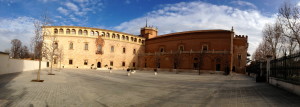 The palace where the first interview between Columbus and the Catholic monarchs took place. It is also the birthplace of Catherine of Aragon and Ferdinand of Austria, and was built between the 13th and 15th centuries
The palace where the first interview between Columbus and the Catholic monarchs took place. It is also the birthplace of Catherine of Aragon and Ferdinand of Austria, and was built between the 13th and 15th centuries
The former Dominican Mother of God convent/school and the Regional Museum of Archeology behind the palace in Alcalá de Henares, Madrid, Spain.
Everywhere I look there are details of centuries upon centuries, layer upon layer of life in this city. On the Calle Mayor, some of the new(er) buildings are held up by re-used Roman pillars.
Some of the new(er) buildings are held up by re-used Roman pillars on the Calle Mayor.
On the same street, the water gutter pipes are finished with unusual bird-serpent-like animals.
I can’t help but believe that these pipes are fashioned after Quetzalcoatl . . .

